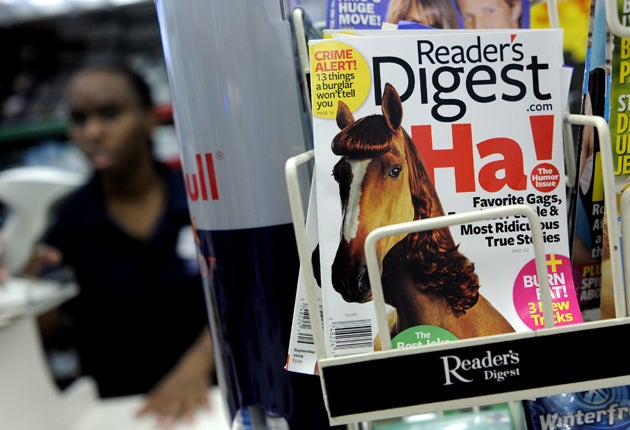Growing up with 'Reader's Digest'
News that the magazine's US arm has filed for bankruptcy unleashed happy memories of its heyday for David Randall

"Dear Reader's Digest, You have been selected from thousands of companies to go into Chapter 11 bankruptcy. Imagine the stir this will cause at your annual general meeting, Reader's Digest, as you ..."
It's always been easy to take the mickey out of Reader's Digest; partly because its content had all the small-mindedness of a suburban net-curtain twitcher, but mainly because, with its mixture of America First paranoia, health obsessions, and risible regulars like "Humour in Uniform", it positively sat up and begged for a ribbing. And, if you grew up in the 1940s-1970s, you couldn't avoid the bloody thing. It was there on your parents' bookshelves, it was there in your dentist's waiting room, and every postal delivery seemed to bring another one of those sinuous personalised prize-draw mail-shots giving the impression you'd already won, or the delivery of some weighty book you'd never ordered. Chapter 11, albeit only for the US arm (the UK arm is unaffected), seems a deserved pricking of corporate smugness.
And yet, many of us of a certain age owe Reader's Digest something. It was, after all, the little A5 magazine, and its pre-chewed articles and uplifting stories, which introduced us at tender years to the world of grown-up reading. Its health articles made us trainee hypochondriacs; its humorous snippets showed us what was not funny; and its pieces on the evils of communism taught us not only to be suspicious of totalitarian states, but also of reading material produced in upstate New York. So, for those too young to know its heady influence, here is what it was like Growing Up With Reader's Digest.
I first came across it in the early 1960s at the age of about 10 when my brother and I opened a sort of speakeasy for lemonade addicts in our garden shed. Seeking to create the right ambience, we sliced the colourful full-page drinks ads from our father's old RDs, and pinned them up, thus adding, we thought, a touch of racy sophistication to the bare wooden walls.
As our habitués solemnly sipped fizzy drinks from plastic beakers, they could gaze at the ads for lemon rum and 10-year-old malts, and imagine themselves transported to a world of lounge-lizardry. (Our father was less impressed when, bowler-hatted and briefcase-bearing, he returned home to find "Bar Open" chalked on the back gate.)
It was while razoring out a particularly fetching Chivas Regal ad one day that my eye was caught by an article. And I saw, for the first time, that this source of alcoholic admass imagery was also stuffed full, as its cover used to proclaim: "Thirty-one articles each month .... Each article of enduring value and interest." The piece might have been something like "Richard M Nixon – A Hero For Our Times", but, at that age, what I noticed was not the right-wingery and uncritically upbeat tone, but that here was something that told me things in boy-sized articles.
It covered everything from technology to foreign affairs ("Computers Are The Future!", and "Charles de Gaulle, France's Man of Destiny" – that kind of thing), but also seemed rather taken with extraordinary animals, exploration, real-life survival yarns, and the sanitised life stories of news-makers. Health was an especial preoccupation. Each issue contained a whole month's worth of worry-fodder: "Are You A Diabetic?"; "What Your Heart Is Trying To Tell You", "Tinnitus: Terror In Your Ear", "Read This Before You Exercise", and, particularly alarming when on the brink of manhood, "Herpes, Scourge of the Sexual Revolution".
There was also a series of articles which explained the workings of the body in easy, "A Doctor Writes" language. They were always entitled something like "I Am John's Adrenal Gland", but never – annoyingly for a teenage boy (and perhaps even more maddening for a girl) – "I Am Janet's Reproductive Parts". Thus was my knowledge of the human body confined to what could be discussed politely in the grill room of a Maryland country club.
But credit where credit is due. The magazine may until very recently have been publishing hopelessly suburban articles like "Getting Through To Your Teenager", or "Casual Dress Codes: Have They Gone Too Far?", but it was about the first mainstream publication to have the courage to take on the tobacco industry. It reported the links between smoking and lung cancer as early as 1952, partly out of a sense of duty to readers, but also, one suspects, because unlike other magazines of the time, it carried no advertising and so had no lucrative cigarette ads to lose.
Advertising came in 1955, and so began the slippery slope that led, via prize draws and gift book marketing, to a business that lost sight of its founder's investment in journalism and became, instead, an exercise in formula editorial and database exploitation. And now, in the US, Chapter 11. Never mind, chaps. After all, hubris is the best medicine.
Subscribe to Independent Premium to bookmark this article
Want to bookmark your favourite articles and stories to read or reference later? Start your Independent Premium subscription today.

Join our commenting forum
Join thought-provoking conversations, follow other Independent readers and see their replies